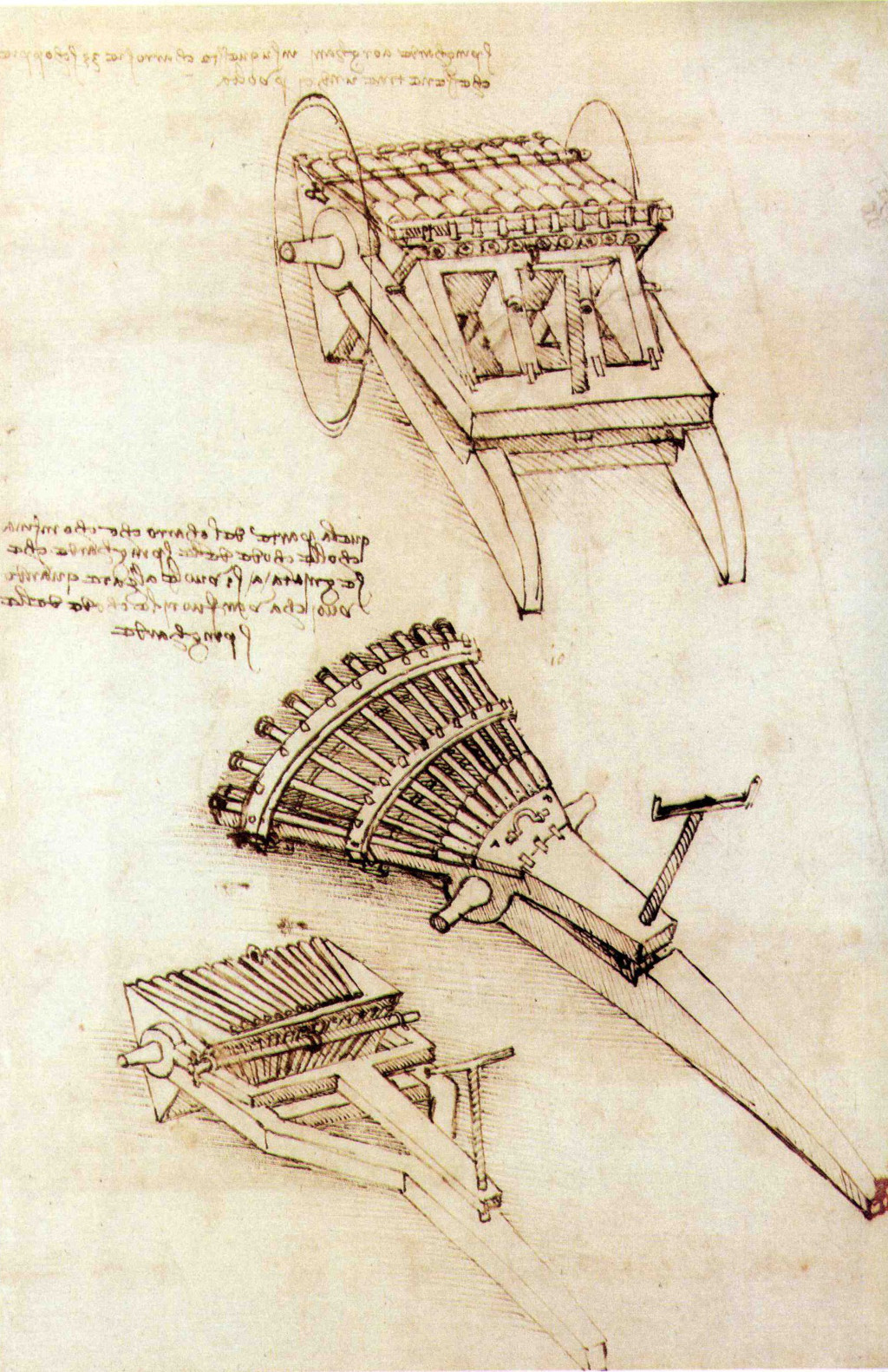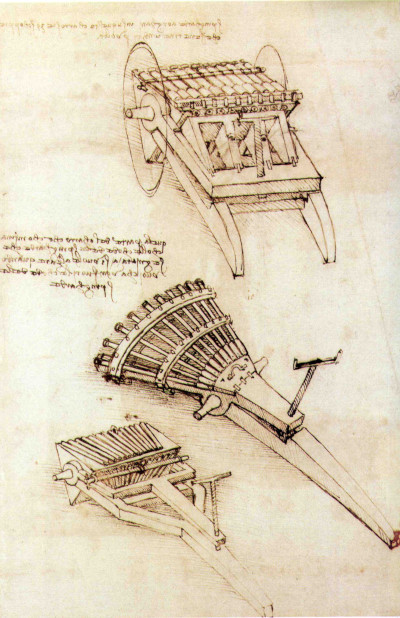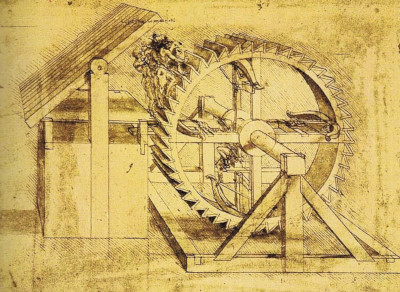Leonardo da Vinci attempted to solve the challenges that existed around multi-firing weapons which had plagued inventors and military engineers for centuries. His Machine Gun designs offered an important evolution towards some of the effective weapons that are available today.
Introduction
Throughout Leonardo's lifetime Italy was a collection of provinces frought with war and conflict, both internally, but also with foreign powers such as France and the Turks. Military advantages were essential in protecting one's self at the very least, and potentially expanding through success on the battlefield.
Leonardo's inventions would cover a wide variety of engineering categories, but it was his military designs that came first, partly in order to gain acceptance and employment as a military engineer. Over time, Leonardo's curiosity would pull him into other areas, such as canal design, maps, flying machines and plenty more.
Leonardo would put together a series of different military weapons, hoping to receive approval for the resources to test and build working prototypes. Sadly, his inventions would never see the light of day within his own lifetime, and would only be enthusiasts and followers of his career who later adapted his designs to bring them to life.
His role as an artist brought creativity into his engineering, but for some his ideas were simply too ambitious and left-field. He did not come from the conventional background of other military engineers, enabling him to look far beyond what had gone before, but this also made it much harder to achieve acceptance for his designs.
He would use whatever resources were available to sketch and think out new ideas. When receiving a large commission for a horse sculpture he was given a large studio in which to plan and build the piece. He used this space to also work in other disciplines, but ultimately none of his inventions would be used.
Besides the machine gun ideas laid out in this article, the inventor would also comes up with a whole plethora of other products includes the likes of an early helicoper, a parachute, diving suit and even an ornithopter, which was based on his study of birds and a general desire to evolve humanity through his creative mind and understanding of science.
This article examines Leonardo da Vinci's machine gun designs, highlighting how they would have worked, and how they moved things of from previous designs by other engineers and inventors. We also look more deeply at the evolution of machine guns towards what we have today.
Table of Contents
- Introduction
- Studies for Leonardo's Machine Gun
- Leonardo's Alternative Design - Tread-wheel Machine Gun
- References
Studies for Leonardo's Machine Gun
Up to this point, multi-firing machine guns had always suffered from taking too long to re-load, leaving them highly vulnerable between bursts of firing. This issue had troubled many civilisations from previous centuries, but Leonardo wanted to find ways to overcome this challenge. His solution was to have multiple racks, with one set of barrels firing whilst the others could be re-loaded.
One of his designs was also termed his 'fan-gun' because of its shape. Barrels were angled across a wide spectrum, allowing a horizontal spread from the gun, simultaneously. This avoided having to rotate a gun manually, but also had the downside of potentially wasting missiles, when an enemy was more closely bunched.
Leonardo was far from a blood-thirsty inventor, but rather he hoped that some of his designs would be intimidating enough to ward off attacks, once opponents had seen the potential destruction of their own armies that might occur if they advanced. This was particularly the case with his Giant Crossbow.
Much of Leonardo's time on these machine gun designs was spent locating potential issues that they might experience, and finding solutions. Some of these concerns would typically involve how the items would be transported to the battlefield, how consistent and accurate would their fire be, and how quickly could the soliders re-load them each time.
 Studies for the Machine Gun, with an array of horizontal barrels, circa 1480s
Studies for the Machine Gun, with an array of horizontal barrels, circa 1480s
Leonardo's Alternative Design - Tread-wheel Machine Gun
Leonardo came up with an alternative design for his machine gun in which a large wheel would be turned by manpower, releasing a constant barrage of missiles at the enemy. The principles behind this cumbersome creation will remind many of some modern weaponry, and many of his designs would inspire later engineers, who themselves would have advantages in terms of lighter materials and evolved thinking.
The disadvantages of this approach is that it would only be able to fire in one direction, and changing angle would be tricky because of its considerable weight. Requiring considerable manpower for its use could also create problems on the battlefield, as could the difficulties in moving it around.
In addition to these machine guns, Leonardo also produced a number of mortars, in which large boulders or bombs could be fired into the air, one at a time. These were designed to be hugely destructive, but without being able to fire frequently. They could serve alongside his rapid fire weapons, in a complementing attack.
The mortars could potentially fire into enemy cities, destroying fortified buildings and walls, opening opportunities to marauding armies to enter. Leonardo would attempt to vary his innovations and see what was accepted, whilst also serving different roles within any conflict.
Many of Leonardo's inventions would sit somewhere between a number of weapons. For example, his wide, fan-shaped machine gun combined cannon and gun design. Ultimately, a number of his ideas would over-complex, leading to issues on the battlefield, but he later returned to simpler methods with his cannons. These would indeed prove significant in later centuries.
For the designs that would become reality, eventually, most did not appear until the 17th century at the earliest. Many have been used commercially and evolved ever since, whilst others have been replicated by enthusiasts who wanted to bring his ideas to life. Some of those required amendments which benefited from modern engineering knowledge, allowing engineers to spot flaws in Leonardo's earlier work.
Leonardo would struggle in his own mind whilst inventing these military weapons. He was entirely against warfare, being something of a pacifist. He understood, however, that Italian politics as they were at the time, meant that his own region could become embroiled in a battle whether it initiated it or not, and that weapons were essential for survival.
Italy was a series of regions, divided by politics and the struggle for power. Additionally, there were foreign forces who also saw an opportunity to expand their own empires. It was a time of great instability, and this continued in Europe for many centuries more. Perhaps Leonardo told himself that these weapons could help stave off attacks, and actually save lives.
It must be remembered that Leonardo da Vinci was constantly having to finance a large studio of apprentices, and it was expected that all masters of that period would have a band of skilled artists and engineers who could help out on various projects. In order to pay them all, Leonardo required constant work, which required the ability to adapt to changing politics across the country.
In conclusion, Leonardo's Machine Gun designs were important contributions to this field, but sadly, they would never be realised within his own lifetime. Many of his ideas can be seen in later versions, however, which started to appear in the 18th century onwards across the western world.
References
- Leonardo. The Complete Paintings and Drawings, Frank Zöllner & Johannes Nathan, Taschen
- Leonardo da Vinci, Walter Isaacson





